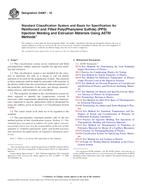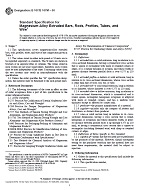1.1 This test method covers a procedure for the determination of basic constituents in petroleum products and lubricants (Note 1). The test method resolves these constituents into groups having weak-base and strong-base ionization properties, provided the dissociation constants of the more strongly basic compounds are at least 1000 times that of the next weaker groups.
1.1.1 This test method covers base numbers up to 70. While it can be extended to higher base numbers, the precision of the test method for base numbers greater than 70 has not been determined.
Note 1 – In new and used oils, the constituents which can be considered to have basic properties are primarily organic and inorganic bases, including amino compounds, although certain salts of heavy metals, salts of weak acids, basic salts of polyacidic compounds, and some additives such as inhibitors or detergents may show basic characteristics.
1.2 This test method can be used to indicate relative changes that occur in an oil during use under oxidizing or other service conditions regardless of the color or other properties of the resulting oil (Note 3). Although the analysis is made under closely specified conditions, the method is not intended to, and does not, result in reported basic properties which can be used under all service conditions to predict performance of an oil; for example, no overall relationship is known between bearing corrosion or the control of corrosive wear in the engine and base number.
Note 2 – Test Method D 4739 was developed as an alternative for the former base number portion of Test Method D 664. Base numbers obtained by this method may or may not be numerically the same as those obtained by the former base number portion of Test Method D 664.
Note 3 – A color indicator titration method is also available in the Test Method D 974 and IP 139. The base numbers obtained by the potentiometric method may or may not be numerically the same as those obtained by Test Method D 974 or equivalent color indicator methods such as given in Federal Test Method Std. No. 791b. Potentiometric methods for base number are also available in Test Method D 2896.
1.3 The values stated in SI units are to be regarded as the standard.
1.4 This standard does not purport to address all of the safety concerns, if any, associated with its use. It is the responsibility of the user of this standard to establish appropriate safety and health practices and determine the applicability of regulatory limitations prior to use.
Product Details
- Published:
- 12/10/2002
- Number of Pages:
- 8
- File Size:
- 1 file , 120 KB


